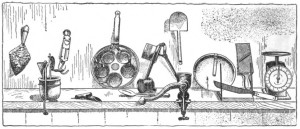From the January, 1901 issue of Good Housekeeping comes the image below, titled “UTENSILS WHICH PAY FOR THEMSELVES, SAVING TIME AND STRENGTH.” These are the utensils that Good Housekeeping considered important at the time for the cook to have, some of which are either not used at all today or are fairly unusual (and some of which are so vital today as to be impossible to cook without).
From left to right, the utensils are (with quotes from Good Housekeeping):
-“a stove polisher, with handle to prevent the soiling of the hands, and a cup on the back in which to hold the polish.” Obviously, this one is no longer necessary, mainly because the vast majority of stoves are no longer made from cast iron and so no longer need to be polished.
-“a mayonnaise mixer.” This is the thing that seems to be attached to the table. Refrigeration and the ability to buy prepared mayonnaise has rendered this unnecessary, as has the shrinking popularity of mayonnaise.
-“hand scales.” I’m not sure why these would have been useful at the time, since scales that sit on a counter are on the far right side of the picture–perhaps the hand scales were used for measuring very heavy items, since they only have a hook at the end. At any rate, American-style recipes don’t use measurements by weight, although European recipes do, so scales are rarely used by cooks today.
-“an apple corer.” While this isn’t popular today, it can be quite useful if you cook a lot with apples.
-“an egg poacher with detachable cups into which the eggs are dropped.” Yes, poached eggs are impossible to make if you don’t have the cups, so if you do like poached eggs than you’ll need something like this, but otherwise these simply aren’t that useful.
-“a mixing spoon.” Very useful, along with:
-“a measuring cup, with rings showing halves and thirds.” These are so necessary that it’s impossible to imagine cooking without them. It’s also helpful if you spring for the measuring cups that mark quarters, as well.
-“a potato ricer, standing on its handles, with perforated bowl through which the potato is forced.” A food ricer can be useful for certain tasks, although I’ve never had to use one.
-“a flat skimmer.” I’m at a loss to figure out what this would be for, other than, I’m guessing, skimming froth from something boiling or simmering. At any rate, I’ve never even seen one for sale today (that is, I’ve never seen a modern version of this).
-“a food chopper, operated by a crank.” As the text below the picture in the article makes apparent, this is essentially a meat grinder. This can be very useful if you’re grinding sausages or hamburger, of course.
-“a cake tin, with a knife which cuts the cake out cleanly.” I used to have one of these. It’s a regular cake pan with an L-shaped metal slat on a pivot at the middle of the pan. The slat follows the bottom of the pan, then comes up the side of the pan. After a cake is baked, the cook turns the slat so that it runs all the way around the pan, completely loosening the cake. While it is an interesting design, non-stick cake pans made this a curiosity.
-“a bread cutter, which slices bread in four different thicknesses.” I’m not exactly sure what this is, but from the illustration looks like a cutting board with guides for the knife so all the cook needs to do is cut along the guide to cut the bread in different thicknesses. Obviously, sliced bread made it so people don’t have to slice their own bread anymore, but this would be useful for someone who bakes their own bread since slicing to certain thicknesses can be a pain.
-“a vegetable slicer, over which anything from a carrot to a lemon may be rubbed and cut thin as a wafer.” This is useful and is still used by cooks today.
-“a pair of weigh scales.” As stated above, measuring by weight is common in Europe but not America, but a scales would be useful for measuring meat, since recipes often measure meat by weight.
Source: “Emancipation in the Kitchen,” Good Housekeeping, January, 1901, 80.
